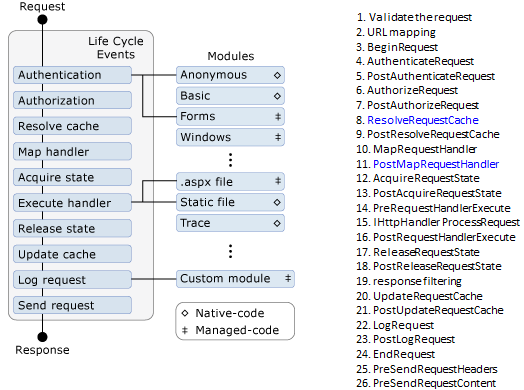我对ASP.NET MVC生命周期还是兴趣很浓,于是提出两个问题:
一个HTTP请求从IIS移交到ASP.NET运行时,ASP.NETMVC是在什么时机获得了控制权并对请求进行处理呢?处理过程又是怎样的?

以IIS7中ASP.NET MVC生命周期为例,来自MSDN的一张HTTP请求处理过程发生事件的简图,后面我列出了一个完整的事件列表。既然ASP.NET MVC还是以ASP.NET运行时为基础那么它必然要在ASP.NET MVC生命周期中对请求进行截获。***反应当然是去web.config里面去翻翻,我们可以看到UrlRoutingModule的配置节:
- <add name="UrlRoutingModule" type="System.Web.Routing.UrlRoutingModule, System.
Web.Routing, Version=3.5.0.0, Culture=neutral, PublicKeyToken=31BF3856AD364E35"/>
看到这里我们的***个问题实际上已经有了答案:时机是在PostResolveRequestCache和PostMapRequestHandler.
ResolveRequestCache event
Occurs when ASP.NET finishes an authorization event to let the caching modules serve requests from the cache, bypassing execution of the event handler (for example, a page or an XML Web service).
源文档
PostMapRequestHandler event
Occurs when ASP.NET has mapped the current request to the appropriate event handler.
源文档
我们使用VS2008中ASP.NET Mvc模板创建一个Demo完成后续的讨论,当我们访问/Home的时候发生了什么呢?
1.Request 请求到来
2.IIS 根据请求特征将处理权移交给 ASP.NET
3.UrlRoutingModule将当前请求在 Route Table中进行匹配
4.UrlRoutingModule在RouteCollection中查找Request匹配的RouteHandler,默认是MvcRouteHandler MvcRouteHandler 创建 MvcHandler实例.
5.MvcHandler执行 ProcessRequest.
6.MvcHandler 使用 IControllerFactory 获得实现了IController接口的实例,找到对应的HomeController
7.根据Request触发HomeController的Index方法
8.Index将执行结果存放在ViewData
9.HomeController的Index方法返回 ActionResult
10.Views/Home/Index.aspx将 ViewData呈现在页面上
11.Index.aspx执行ProcessRequest方法
12.Index.aspx执行Render方法 输出到客户端
通过阅读ASP.NET Mvc的源码,我们可以得到更为详细的处理过程,我尽可能的忽略掉枝节,强调请求处理的流程.我们从Global.asax.cs文件切入。
【编辑推荐】
























